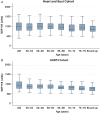Association of growth differentiation factor 11/8, putative anti-ageing factor, with cardiovascular outcomes and overall mortality in humans: analysis of the Heart and Soul and HUNT3 cohorts
- PMID: 26294790
- PMCID: PMC4685178
- DOI: 10.1093/eurheartj/ehv385
Association of growth differentiation factor 11/8, putative anti-ageing factor, with cardiovascular outcomes and overall mortality in humans: analysis of the Heart and Soul and HUNT3 cohorts
Abstract
Aims: Growth differentiation factor 11 and/or its homologue growth differentiation factor 8 (GDF11/8) reverses age-related cardiac hypertrophy and vascular ageing in mice. We investigated whether GDF11/8 associates with cardiovascular outcomes, left ventricular hypertrophy (LVH), or age in humans.
Methods and results: We measured plasma GDF11/8 levels in 928 participants with stable ischaemic heart disease in the Heart and Soul study. We adjudicated heart failure hospitalization, stroke, myocardial infarction, death, and their composite endpoint. Left ventricular hypertrophy was evaluated by echocardiography. We used multivariable Cox proportional hazards models to compare rates of cardiovascular events and death across GDF11/8 quartiles and logistic regression models to evaluate the association between GDF11/8 and LVH. Four hundred and fifty participants (48.5%) experienced a cardiovascular event or death during 8.9 years of follow-up. The adjusted risk of the composite endpoint was lower in the highest compared with the lowest GDF11/8 quartile [hazard ratio (HR), 0.45; 95% confidence interval (CI), 0.33-0.60; P < 0.001]. We replicated this relationship of GDF11/8 to adverse events in 971 participants in the HUNT3 cohort (adjusted HR, 0.34; 95% CI, 0.23-0.51; P < 0.001). Left ventricular hypertrophy was present in 368 participants (39.7%) at baseline. Participants in the highest quartile of GDF11/8 were less likely to have LVH than those in the lowest quartile (adjusted OR, 0.55; 95% CI, 0.35-0.86; P = 0.009). GDF11/8 levels were lower in older individuals (P < 0.001).
Conclusion: In patients with stable ischaemic heart disease, higher GDF11/8 levels are associated with lower risk of cardiovascular events and death. Our findings suggest that GDF11/8 has similar cardioprotective properties in humans to those demonstrated in mice.
Keywords: Ageing; Cardiovascular outcomes; Epidemiology; Growth differentiation factor 11 and 8; Hypertrophy.
Published on behalf of the European Society of Cardiology. All rights reserved. © The Author 2015. For permissions please email: journals.permissions@oup.com.
Figures




Comment in
-
Antiageing concepts and cardiovascular disease.Eur Heart J. 2015 Dec 21;36(48):3435-6. doi: 10.1093/eurheartj/ehv412. Epub 2015 Aug 20. Eur Heart J. 2015. PMID: 26294791 No abstract available.
References
-
- Loffredo FS, Steinhauser ML, Jay SM, Gannon J, Pancoast JR, Yalamanchi P, Sinha M, Dall'Osso C, Khong D, Shadrach JL, Miller CM, Singer BS, Stewart A, Psychogios N, Gerszten RE, Hartigan AJ, Kim MJ, Serwold T, Wagers AJ, Lee RT. Growth differentiation factor 11 is a circulating factor that reverses age-related cardiac hypertrophy. Cell 2013;153:828–839. - PMC - PubMed
-
- Sinha M, Jang YC, Oh J, Khong D, Wu EY, Manohar R, Miller C, Regalado SG, Loffredo FS, Pancoast JR, Hirshman MF, Lebowitz J, Shadrach JL, Cerletti M, Kim MJ, Serwold T, Goodyear LJ, Rosner B, Lee RT, Wagers AJ. Restoring systemic GDF11 levels reverses age-related dysfunction in mouse skeletal muscle. Science 2014;344:649–652. - PMC - PubMed

